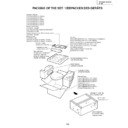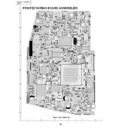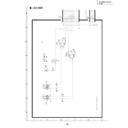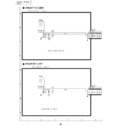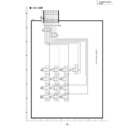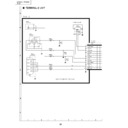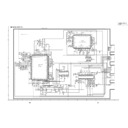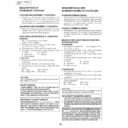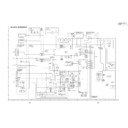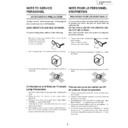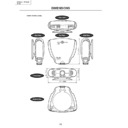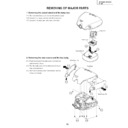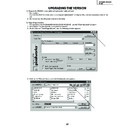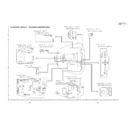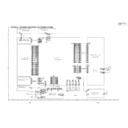Read Sharp XV-Z200E (serv.man11) Service Manual online
22
XV-Z200U/E, XV-Z201E
DT-300
DT-300
ELECTRICAL ADJUSTMENT
3-2
G-Bright / G-
Contrast
(Manual or auto
adjustment)
Contrast
(Manual or auto
adjustment)
1. Group: AD
S u b j e c t : G - B R I G H T
(Black level)
G - C O N T R A S T ( W h i t e
level)
(Black level)
G - C O N T R A S T ( W h i t e
level)
2. Feed the window pattern
signal containing 91%
(0.64Vp-p) G signal and
0% level.
(Process/Gamma interac-
tion)
(SVGA or XGA)
Input 2 RGB input
(0.64Vp-p) G signal and
0% level.
(Process/Gamma interac-
tion)
(SVGA or XGA)
Input 2 RGB input
1. Using CA100, observe the chromaticity of the 0%
window pattern portion.
2. In the screen with missing bits, change G-Bright
until y value for bright red changes to the black
side point where it will not change any more. From
here, raise the level by a single point where the
first missing bits occur (value change of more
than 5/1000), and adjust the level to this point.
side point where it will not change any more. From
here, raise the level by a single point where the
first missing bits occur (value change of more
than 5/1000), and adjust the level to this point.
3. Using CA100, observe the chromaticity of the 91%
G signal portion.
4. In the screen with missing bits, change G-Con-
trast until y value for bright red changes to the
black side point where it will not change any more.
From here, raise the level by a single point where
the first missing bits occur
(value change of more than 5/1000), and adjust
the level to this point.
black side point where it will not change any more.
From here, raise the level by a single point where
the first missing bits occur
(value change of more than 5/1000), and adjust
the level to this point.
1
Initialization of
EEPROM
EEPROM
1. Turn on the power (the
lamp lights up) and warm
up the system for 15 min-
utes.
up the system for 15 min-
utes.
1. Carry out the following setting.
Using the remote controller or press S2002 to
enter the process mode, and execute SS2 on SS
menu.
enter the process mode, and execute SS2 on SS
menu.
2
Adjustment of
CW index
CW index
1. Input the gradation pat-
tern of RGB.
(SVGA60Hz or XGA)
(SVGA60Hz or XGA)
2. S e l e c t t h e fo l l o w i n g
group and subject.
Group: DLP
Subject: Select INDEX
DELAY.
Group: DLP
Subject: Select INDEX
DELAY.
1. Select subject and make adjustment so that the
lamp gradation patterns of R, G and B should be
smooth without noise.
smooth without noise.
R
G
B
3-1
R-Bright / R-
Contrast
(Manual or auto
adjustment)
Contrast
(Manual or auto
adjustment)
1. Group: AD
S u b j e c t : R - B R I G H T
(Black level)
R - C O N T R A S T ( W h i t e
level)
(Black level)
R - C O N T R A S T ( W h i t e
level)
2. Feed the window pattern
signal containing 91%
(0.64Vp-p) R signal and
0% level.
(Process/Gamma interac-
tion)
(SVGA or XGA)
Input 2 RGB input
(0.64Vp-p) R signal and
0% level.
(Process/Gamma interac-
tion)
(SVGA or XGA)
Input 2 RGB input
1. Using CA100, observe the chromaticity of the 0%
window pattern portion.
2. In the screen with missing bits, change R-Bright
until x value for bright red changes to the black
side point where it will not change any more. From
here, raise the level by a single point where the
first missing bits occur (value change of more
than 5/1000), and adjust the level to this point.
side point where it will not change any more. From
here, raise the level by a single point where the
first missing bits occur (value change of more
than 5/1000), and adjust the level to this point.
3. Using CA100, observe the chromaticity of the 91%
R signal portion.
4. In the screen with missing bits, change R-Con-
trast until x value for bright red changes to the
black side point where it will not change any more.
From here, raise the level by a single point where
the first missing bits occur (value change of more
than 5/1000), and adjust the level to this point.
black side point where it will not change any more.
From here, raise the level by a single point where
the first missing bits occur (value change of more
than 5/1000), and adjust the level to this point.
No.
Adjusting point
Adjusting conditions
Adjusting procedure
No.
Adjusting point
Adjusting conditions
Adjusting procedure
23
XV-Z200U/E, XV-Z201E
DT-300
DT-300
3-3
B-Bright / B-
Contrast
(Manual or auto
adjustment)
Contrast
(Manual or auto
adjustment)
1. Group: AD
Subject: B-BRIGHT (Black
level)
B - C O N T R A S T ( W h i t e
level)
level)
B - C O N T R A S T ( W h i t e
level)
2. Feed the window pattern
signal containing 91%
(0.64Vp-p) B signal and
0% level.
(Process/Gamma interac-
tion)
(SVGA or XGA)
Input 2 RGB input
(0.64Vp-p) B signal and
0% level.
(Process/Gamma interac-
tion)
(SVGA or XGA)
Input 2 RGB input
1. Using CA100, observe the chromaticity of the 0%
window pattern portion.
2. In the screen with missing bits, change B-Bright
until y value for bright red changes to the black
side point where it will not change any more. From
here, raise the level by a single point where the
first missing bits occur
(value change of more than 5/1000), and adjust
the level to this point.
side point where it will not change any more. From
here, raise the level by a single point where the
first missing bits occur
(value change of more than 5/1000), and adjust
the level to this point.
3. Using CA100, observe the chromaticity of the 91%
B signal portion.
4. In the screen with missing bits, change B-Con-
trast until y value for bright red changes to the
black side point where it will not change any more.
From here, raise the level by a single point where
the first missing bits occur
(value change of more than 5/1000), and adjust
the level to this point.
black side point where it will not change any more.
From here, raise the level by a single point where
the first missing bits occur
(value change of more than 5/1000), and adjust
the level to this point.
4
DTV Bright /
Contrast
(Manual or auto
adjustment)
Contrast
(Manual or auto
adjustment)
1. Feed the 480P 100%/0%
black/white window pat-
tern signal.
tern signal.
2. Group: DTV
Subject: BRIGHT (Black
level)
CONTRAST (White level)
(Process/Gamma interac-
tion)
Input 2 Color difference in-
put
level)
CONTRAST (White level)
(Process/Gamma interac-
tion)
Input 2 Color difference in-
put
1. Using CA100, observe the chromaticity of the 0%
black window pattern portion.
2. In the screen with missing bits, change Bright
until y value for bright green changes to the black
side point where it will not change any more. From
here, raise the level by a single point where the
first missing bits occur
(value change of more than 5/1000), and adjust
the level to this point.
side point where it will not change any more. From
here, raise the level by a single point where the
first missing bits occur
(value change of more than 5/1000), and adjust
the level to this point.
3. Using CA100, observe the chromaticity of the 100%
white window pattern portion.
4. In the screen with missing bits, change Contrast
until y value for bright green changes to the black
side point where it will not change any more. From
here, raise the level by a single point where the
first missing bits occur
(value change of more than 5/1000), and adjust
the level to this point.
side point where it will not change any more. From
here, raise the level by a single point where the
first missing bits occur
(value change of more than 5/1000), and adjust
the level to this point.
5
DTV Tint
1. Group: DTV
Subject: Tint
1. Check the fixed value.
Tint: 8
6
DTV Color
Saturation
Level
Saturation
Level
1. Group: DTV
Subject: Color
1. Check the fixed value.
Color: 10
No.
Adjusting point
Adjusting conditions
Adjusting procedure
24
XV-Z200U/E, XV-Z201E
DT-300
DT-300
12
VIDEO Color
Saturation Level
Saturation Level
1. Group: VIDEO
Subject: N-Color
P-Color
S-Color
P-Color
S-Color
1. Check the fixed values.
N-Color: 10
P-Color: 10
S-Color: 10
P-Color: 10
S-Color: 10
11
VIDEO Tint
1. Group: VIDEO
Subject: N-Tint
P-Tint
S-Tint
P-Tint
S-Tint
1. Check the fixed values.
N-Tint: 8
P-Tint: 4
S-Tint: 4
P-Tint: 4
S-Tint: 4
9
DTV Color
Saturation Level
Saturation Level
1. Group: DVD
Subject: Color
1. Check the fixed value.
Color: 10
10
VIDEO Bright /
Contrast
(Manual or auto
adjustment)
Contrast
(Manual or auto
adjustment)
1. Feed the NTSC VIDEO
1 0 0 % / 0 % bl a ck / w h i t e
window pattern signal.
window pattern signal.
2. Group: VIDEO
Subject: BRIGHT (Black
level)
CONTRAST (White level)
( P r o c e s s / G a m m a
interaction)
Input 4 Composite video
input
level)
CONTRAST (White level)
( P r o c e s s / G a m m a
interaction)
Input 4 Composite video
input
1. Using CA100, observe the chromaticity of the 0%
black window pattern portion.
2. In the screen with missing bits, change Bright until
y value for bright green changes to the black side
point where it will not change any more. From here,
raise the level by a single point where the first
missing bits occur
(value change of more than 5/1000), and adjust
the level to this point.
point where it will not change any more. From here,
raise the level by a single point where the first
missing bits occur
(value change of more than 5/1000), and adjust
the level to this point.
3. Using CA100, observe the chromaticity of the 100%
white window pattern portion.
4. In the screen with missing bits, change Contrast
until y value for bright green changes to the black
side point where it will not change any more. From
here, raise the level by a single point where the
first missing bits occur
(value change of more than 5/1000), and adjust
the level to this point.
side point where it will not change any more. From
here, raise the level by a single point where the
first missing bits occur
(value change of more than 5/1000), and adjust
the level to this point.
8
DVD Tint
1. Check the fixed value.
Tint: 4
1. Group: DVD
Subject: Tint
7
DVD Bright /
Contrast
(Manual or auto
adjustment)
Contrast
(Manual or auto
adjustment)
1. Feed the 480I 100%/0%
black/white window pat-
tern signal.
tern signal.
2. Group: DVD
Subject: BRIGHT (Black
level)
CONTRAST (White level)
(Process/Gamma interac-
tion)
Input 2 Color difference in-
put
level)
CONTRAST (White level)
(Process/Gamma interac-
tion)
Input 2 Color difference in-
put
1. Using CA100, observe the chromaticity of the 0%
black window pattern portion.
2. In the screen with missing bits, change Bright
until y value for bright green changes to the black
side point where it will not change any more. From
here, raise the level by a single point where the
first missing bits occur
(value change of more than 5/1000), and adjust
the level to this point.
side point where it will not change any more. From
here, raise the level by a single point where the
first missing bits occur
(value change of more than 5/1000), and adjust
the level to this point.
3. Using CA100, observe the chromaticity of the 100%
white window pattern portion.
4. In the screen with missing bits, change Contrast
until y value for bright green changes to the black
side point where it will not change any more. From
here, raise the level by a single point where the
first missing bits occur
(value change of more than 5/1000), and adjust
the level to this point.
side point where it will not change any more. From
here, raise the level by a single point where the
first missing bits occur
(value change of more than 5/1000), and adjust
the level to this point.
No.
Adjusting point
Adjusting conditions
Adjusting procedure
25
XV-Z200U/E, XV-Z201E
DT-300
DT-300
15
Offset
1. Feed the NTSC VIDEO
75% gray scale signal.
2. Group: VIDEO
3. Subject: CB-Offset
3. Subject: CB-Offset
CR-Offset
4. Make sure to perform this
setting after the DVD
white balance adjustment.
white balance adjustment.
1. Adjust the white balance to x=286 and y=314.
2. Write the respective settings of the CB-Offset and CR-
2. Write the respective settings of the CB-Offset and CR-
Offset into the CB-Offset and CR-Offset of DTV and
DVD.
DVD.
14
CCA Setting
1. Feed the XGA 75% color
signal for each of R, G, B,
W, Mg, Cy and Ye.
W, Mg, Cy and Ye.
2. Make sure to perform this
setting after the DVD
white balance adjustment.
white balance adjustment.
1. Feed the XGA 75% gray scale signal, and record the
values of x, y and Y.
2. Feed the XGA 75% green signal, and record the values
of x, y and Y.
3. Feed the XGA 75% red signal, and record the values
of x, y and Y.
4. Feed the XGA 75% blue signal, and record the values
of x, y and Y.
5. Feed the XGA 75% cyan signal, and record the values
of x, y and Y.
6. Feed the XGA 75% magenta signal, and record the
values of x, y and Y.
7. Feed the XGA 75% yellow signal, and record the
values of x, y and Y.
8. Through RS232C, send each measurement data to
PIXEL.
13
DVD White
balance
(Auto
adjustment)
balance
(Auto
adjustment)
1. Feed the XGA 75% gray
scale signal.
2. Group: PIXEL
Subject: R-GAIN (R)
B-GAIN (B)
Input 2 RGB input
XGA or SVGA
B-GAIN (B)
Input 2 RGB input
XGA or SVGA
1. Adjust the white balance by controlling R-GAIN and
B-GAIN.
(Adjust x=286 and y=314.)
(Adjust x=286 and y=314.)
16
DLP Voltage
(Reference)
(Reference)
1. Perform this setting after replacement of the DLP chip
or when the combination of the DLP chip and the
formatter PWB has been changed.
formatter PWB has been changed.
2. Rating B C D E
1. Read the voltage rating
shown on the DLP.
2. Make the switch setting
corresponding to the rating.
(Inside the formatter PWB)
(Inside the formatter PWB)
17
DVI digital
performance
check
performance
check
1. Make sure that the video output is normal.
1. Receive the digital signal.
18
Off-timer
performance
check
performance
check
1. Select OFF in the process mode.
Make sure that the off-timer starts with 5-minute
display, counts 1 minute in 1 second, and turns the
set off upon 0-minute display.
display, counts 1 minute in 1 second, and turns the
set off upon 0-minute display.
19
Thermistor
performance
check
performance
check
1. Heat the thermistor using a
dryer.
1. Make sure the "TEMP" is displayed.
1. Make the following settings
Destination
Process adjustment Remote controller setting
Europe
SS3
Factory setting 3
North America
SS4
Factory setting 4
20
Factory settings




